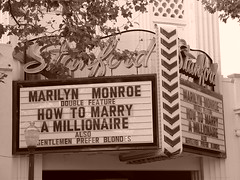Get-rich-quick schemes
Get-rich-quick schemes are extremely varied. For example, fake franchises, real estate “sure things”, get-rich-quick books, wealth-building seminars, self-help gurus, sure-fire inventions, useless products, chain letters, fortune tellers, quack doctors, miracle pharmaceuticals, Nigerian money scams, charms and talismans are all used to separate the mark from his money. Variations include the pyramid scheme, Ponzi scheme and Matrix sale.
Count Victor Lustig sold the “money-printing machine” which could copy $100 bills. The client, sensing huge profits, would buy the machines for a high price (usually over $30,000). Over the next twelve hours, the machine would produce just two more $100 bills, but after that it produced only blank paper, as its supply of hidden $100 bills would have become exhausted. This type of scheme is also called the “money box” scheme.
…
The wire game, as depicted in the movie The Sting, trades on the promise of insider knowledge to beat a gamble, stock trade or other monetary action. In the wire game, a “mob” composed of dozens of grifters simulates a “wire store”, i.e., a place where results from horse races are received by telegram and posted on a large board, while also being read aloud by an announcer. The griftee is given secret foreknowledge of the race results minutes before the race is broadcast, and is therefore able to place a sure bet at the wire store. In reality, of course, the con artists who set up the wire store are the providers of the inside information, and the mark eventually is led to place a large bet, thinking it to be a sure win. At this point, some mistake is made, which actually makes the bet a loss. …
Salting or to salt the mine are terms for a scam in which gems or gold ore are planted in a mine or on the landscape, duping the greedy mark into purchasing shares in a worthless or non-existent mining company.[2] During the Gold Rush, scammers would load shotguns with gold dust and shoot into the sides of the mine to give the appearance of a rich ore, thus “salting the mine”. …
The Spanish Prisoner scam – and its modern variant, the advance fee fraud or Nigerian scam – take advantage of the victim’s greed. The basic premise involves enlisting the mark to aid in retrieving some stolen money from its hiding place. The victim sometimes believes he can cheat the con artists out of their money, but anyone trying this has already fallen for the essential con by believing that the money is there to steal (see also Black money scam). …
Many conmen employ extra tricks to keep the victim from going to the police. A common ploy of investment scammers is to encourage a mark to use money concealed from tax authorities. The mark cannot go to the authorities without revealing that he or she has committed tax fraud. Many swindles involve a minor element of crime or some other misdeed. The mark is made to think that he or she will gain money by helping fraudsters get huge sums out of a country (the classic Nigerian scam); hence marks cannot go to the police without revealing that they planned to commit a crime themselves.
…
Gold brick scams
Gold brick scams involve selling a tangible item for more than it is worth; named after selling the victim an allegedly golden ingot which turns out to be gold-coated lead.
…
Pig-in-a-poke originated in the late Middle Ages. The con entails a sale of a (suckling) “pig” in a “poke” (bag). The bag ostensibly contains a live healthy little pig, but actually contains a cat (not particularly prized as a source of meat, and at any rate, quite unlikely to grow to be a large hog). If one buys a “pig in a poke” without looking in the bag (a colloquial expression in the English language, meaning “to be a sucker”), the person has bought something of less value than was assumed, and has learned firsthand the lesson caveat emptor.
…
The Thai gem scam involves layers of con men and helpers who tell a tourist in Bangkok of an opportunity to earn money by buying duty-free jewelry and having it shipped back to the tourist’s home country. The mark is driven around the city in a tuk-tuk operated by one of the con men, who ensures that the mark meets one helper after another, until the mark is persuaded to buy the jewelry from a store also operated by the swindlers. The gems are real but significantly overpriced. This scam has been operating for 20 years in Bangkok, and is said to be protected by Thai police and politicians. A similar scam usually runs in parallel for custom-made suits.
…
Extortion or false-injury tricks
The badger game extortion is often perpetrated on married men. The mark is deliberately coerced into a compromising position, a supposed affair for example, then threatened with public exposure of his acts unless blackmail money is paid.
…
The Melon Drop is a scam in which the scammer will intentionally bump into the mark and drop a package containing (already broken) glass. He will blame the damage on the clumsiness of the mark, and demand money in compensation. This con arose when artists discovered that the Japanese paid large sums of money for watermelons. The scammer would go to a supermarket to buy a cheap watermelon, then bump into a Japanese tourist and set a high price.
…
Gambling tricks
Three-card Monte, ‘Find The Queen’, the “Three-card Trick”, or “Follow The Lady”, is (except for the props) essentially the same as the probably centuries-older shell game or thimblerig. The trickster shows three playing cards to the audience, one of which is a queen (the “lady”), then places the cards face-down, shuffles them around and invites the audience to bet on which one is the queen. At first the audience is skeptical, so the shill places a bet and the scammer allows him to win. In one variation of the game, the shill will (apparently surreptitiously) peek at the lady, ensuring that the mark also sees the card. This is sometimes enough to entice the audience to place bets, but the trickster uses sleight of hand to ensure that they always lose, unless the conman decides to let them win, hoping to lure them into betting much more. The mark loses whenever the dealer chooses to make him lose. This con appears in the Eric Garcia novel Matchstick Men and is featured in the movie Edmond.
A variation on this scam exists in Barcelona, Spain, but with the addition of a pickpocket. The dealer and shill behave in an overtly obvious manner, attracting a larger audience. When the pickpocket succeeds in stealing from a member of the audience, he signals the dealer. The dealer then shouts the word “aqua”, and the three split up. The audience is left believing that “aqua” is a code word indicating the police are coming, and that the performance was a failed scam.
In the Football Picks Scam the scammer sends out tip sheet stating a game will go one way to 100 potential victims and the other way to another 100. The next week, the 100 or so who received the correct answer are divided into two groups and fed another pick. This is repeated until a small population have (apparently) received a series of supernaturally perfect picks, then the final pick is offered for sale. Despite being well-known (it was even described completely on an episode of The Simpsons and used by Derren Brown in “The System”), this scam is run almost continuously in different forms by different operators. The sports picks can also be replaced with securities, or any other random process, in an alternative form. This scam has also been called the inverted pyramid scheme, because of the steadily decreasing population of victims at each stage.
…
Visitors to Las Vegas or other gambling towns often encounter the Barred Winner scam, a form of advance fee fraud performed in person. The artist will approach his mark outside a casino with a stack or bag of high-value casino chips and say that he just won big, but the casino accused him of cheating and threw him out without letting him redeem the chips. The artist asks the mark to go in and cash the chips for him. The artist will often offer a percentage of the winnings to the mark for his trouble. But, when the mark agrees, the artist feigns suspicion and asks the mark to put up something of value “for insurance”. The mark agrees, hands over jewelry, a credit card or their wallet, then goes in to cash the chips. When the mark arrives at the cashier, they are informed the chips are fake. The artist, by this time, is long gone with the mark’s valuables.
False reward tricks
The glim-dropper requires several accomplices, one of whom must be a one-eyed man. One grifter goes into a store and pretends he has lost his glass eye. Everyone looks around, but the eye cannot be found. He declares that he will pay a thousand-dollar reward for the return of his eye, leaving contact information. The next day, an accomplice enters the store and pretends to find the eye. The storekeeper (the intended griftee), thinking of the reward, offers to take it and return it to its owner. The finder insists he will return it himself, and demands the owner’s address. Thinking he will lose all chance of the reward, the storekeeper offers a hundred dollars for the eye. The finder bargains him up to $250, and departs.…
The fiddle game uses the pigeon drop technique. A pair of con men work together, one going into an expensive restaurant in shabby clothes, eating, and claiming to have left his wallet at home, which is nearby. As collateral, the con man leaves his only worldly possession, the violin that provides his livelihood. After he leaves, the second con man swoops in, offers an outrageously large amount (for example $50,000) for such a rare instrument, then looks at his watch and runs off to an appointment, leaving his card for the mark to call him when the fiddle-owner returns. The mark’s greed comes into play when the “poor man” comes back, having gotten the money to pay for his meal and redeem his violin. The mark, thinking he has an offer on the table, then buys the violin from the fiddle player (who “reluctantly” sells it eventually for, say, $5,000). The result is the two conmen are $5,000 richer (less the cost of the violin), and the mark is left with a cheap instrument.
…
Other confidence tricks and techniques
…
The Landlord Scam advertises an apartment for rent at an attractive price. The con artist, usually someone who is house-sitting or has a short-term sublet at the unit, takes a deposit and first/last month’s rent from every person who views the suite. When move-in day arrives, the con artist is of course gone, and the apartment belongs to none of the angry people carrying boxes.
…
Change raising is a common short con and involves an offer to change an amount of money with someone, while at the same time taking change or bills back and forth to confuse the person as to how much money is actually being changed. The most common form, “the Short Count”, has been featured prominently in several movies about grifting, notably Nueve Reinas, The Grifters and Paper Moon. A con artist shopping at, say a gas station, is given 80 cents in change because he lacks two dimes to complete the sale (say the sale cost is $19.20 and the con man has a 20 dollar bill). He goes out to his car and returns a short time later, with 20 cents. He returns them, saying that he found the rest of the change to make a dollar, and asking for a bill so he will not have to carry coins. The confused store clerk agrees, exchanging a dollar for the 20 cents the conman returned. In essence, the mark makes change twice.
…
Beijing tea scam is a famous scam in and around Beijing. The artists (usually female and working in pairs) will approach tourists and try to make friends. After chatting, they will suggest a trip to see a tea ceremony, claiming that they have never been to one before. The tourist is never shown a menu, but assumes that this is how things are done in China. After the ceremony, the bill is presented to the tourist, charging upwards of $100 per head. The artists will then hand over their bills, and the tourists are obliged to follow suit.













